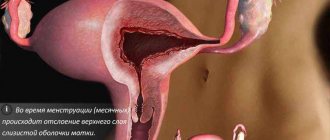(0 votes, rating 0 out of 5)
If the delay is 5 days and pulls in the lower abdomen, most likely these are signs of early pregnancy. Determining an accurate diagnosis, especially when conception has occurred recently, is quite difficult. Even the test may not be indicative. If fertilization occurs as desired, there is no need to rush to see a doctor; it is better to wait another week. But in the opposite situation, it is worth going to the clinic early, because early abortion is less dangerous and practically does not entail harmful consequences for the reproductive abilities of the body.
Woman's monthly cycle and delay concept
The first menstruation (menarche) begins in a girl at the age of 11–13 years, but deviations of 1–2 years in one direction or another are not a pathology. During the period of hormonal development, a girl may experience regular delays in menstruation. Critical days come once every one or two months, the breaks between them can be up to six months.
As the functions of the reproductive organs improve, such deviations will go away on their own. If symptoms of an unstable menstrual cycle persist for more than two years, parents need to show the girl to a doctor for early detection of gynecological problems and hormonal disorders.
For representatives of the fair sex in reproductive age, the average cycle length is 28 days, but its duration of 21–35 days is not a deviation from the norm. The countdown starts from the first day of menstruation. The absence of menstrual bleeding in a woman outside of pregnancy, accompanied by nagging pain in the abdomen and lower back, can be caused by several factors:
- long-term treatment with antibacterial drugs;
- onset of menopause (aged 45–55 years);
- use of emergency contraception (Postinor, Escapelle), which can greatly affect hormonal levels;
- period of adaptation to a new oral contraceptive;
- abrupt cessation of OC use;
- consequences of abortion, miscarriage or diagnostic uterine curettage;
- cauterization of the cervix;
- hysteroscopy, colposcopy.
A delay can be considered the absence of menstruation for 7–10 days. A one-time fluctuation in the cycle that causes a delay of menstruation for a period of 2-3 or even five days is not a pathology and can be triggered by natural factors - stress, colds, climate change, etc.
On what day can you take a pregnancy test?
To get an answer to the question of why there are no regular periods, but the test is negative and the lower abdomen hurts, you need to learn how to use pregnancy tests correctly, in order to avoid getting a false result. Most standard test strips are able to detect conception already 1-2 days after the start of the delay, since they react to the level of hCG in the urine from 25 mIU/ml. In the early stages of pregnancy, the device may not indicate pregnancy, so it is recommended to carry out self-diagnosis again after three or four days.
A reliable test result will be obtained only if the following rules are observed:
- Do the test at a time that coincides with the maximum peak of hCG content in urine - immediately after waking up.
- Collect urine in a sterile container.
- Carry out hygienic treatment of the intimate area using neutral soap.
- Hold the test strip vertically, do not lower it into the urine lower than the arrow on the device.
- To evaluate the result, place the test on a dry, clean surface, not located near a source of elevated temperature.
- Study the result for 5–10 minutes.
If you do not want to collect urine in a container and get an error when using the test incorrectly, you can use a more modern device - inkjet, digital and electronic. The advantage of such devices is that they respond to a lower concentration of hCG in urine, from 10–15 mIU/ml, and this facilitates the early diagnosis of conception.
Find out in the article at the link how many days before your period you can take a pregnancy test if it is highly sensitive.
Possible reasons for a delay in a negative test
When a woman has a delay of 3 or 4 days in her period, the lower abdomen is tight, but an ultrasound examination and test have confirmed that pregnancy has not occurred, it is necessary to seek medical help in the next week. Sometimes the absence of menstruation is due to non-hazardous factors that a woman can correct on her own:
- Stress and excessive psycho-emotional overload.
- Physical exhaustion when a girl is involved in strenuous sports or is engaged in exhausting work.
- Eating a large amount of unhealthy foods, fatty, over-salted, smoked foods with preservatives, flavor enhancers and synthetic additives.
- Abuse of cigarettes and alcoholic beverages.
- Deficiency of folic acid, vitamins C, E, group B, iron as a result of strict diets.
- A sharp change in climate can cause a delay of up to 10–12 days.
- A recent illness of an inflammatory-infectious nature.
- The postpartum period and breastfeeding - unstable hormonal levels can cause a delay, which will be restored after the complete end of breastfeeding.
- Excess and low weight - adipose tissue contains female hormones estrogens, which affect the process of maturation of follicles in the appendages and the timely onset of ovulation. If there are too many or few of them, the process of folliculogenesis is disrupted, and the time of the ovulatory phase is shifted. There is a delay in menstruation, accompanied by the usual pain in the abdomen, radiating to the back.
- The use of hormonal contraceptives - pills can cause a delay in menstruation if used incorrectly or self-prescribed, when a woman chooses a contraceptive not after examination by a doctor, but on the advice of a friend.
To stabilize the cycle, a girl needs to eat well, rest, sleep at least 8–9 hours a day, protect herself from stress and excessive physical activity, and keep her body weight under control.
Read about how to quickly induce menstruation at home if there is a delay not caused by pregnancy or illness.
Methods of treating diseases
Acute conditions such as ectopic pregnancy or ovarian inflammation require surgery. After it, antibacterial therapy is carried out, medications are taken to eliminate the symptoms of the disease.
For the treatment of other gynecological disorders, it may be necessary to take hormonal drugs such as Yarina-35 and Jasmine. A balanced diet that maintains the level of natural hormones is considered an important condition for recovery:
You should not abuse sweets or alcohol, you must completely quit smoking; food should be fresh and light, without an abundance of refined and animal fats: preference is given to baked and fresh fruits, vegetables, lean meat, unrefined oils; It is important to drink a lot of water and avoid dehydration; You need to eat in moderation, without overeating and excessive “hungry” intervals.
The same nutritional rules should be followed when pathologies of the gastrointestinal tract and urinary system are detected.
Ectopic pregnancy
A dangerous cause of symptoms, when the test is negative, but there have been no periods for two weeks and the lower abdomen hurts, is an ectopic pregnancy. When the fertilized egg develops outside the reproductive organ (in the cavity of the ovary, fallopian tube, peritoneum), the test may show one stripe or a very pale second.
Ectopic pregnancy is dangerous for a woman’s life, as it can result in rupture of the tube and the onset of intense internal bleeding. To avoid dangerous complications and death, you need to know about the warning signs of pathology:
- pain in the lower abdomen, similar to premenstrual pain, which radiates to the lower back, but becomes more intense every day (discomfort may be felt more strongly on one side);
- low-grade fever for one to two weeks in a row;
- nausea with vomiting (vomiting does not bring relief);
- chills, fever, sticky sweat;
- reduction in blood pressure to critical levels;
- fainting, weakness;
- lack of appetite.
Having noticed similar symptoms in herself, when there are no periods during the second week, and the test shows one strip, the girl should urgently call an ambulance and go to a medical facility.
Positive test and some white discharge as a sign of pregnancy
Unpleasant, pulling sensations in the lower abdomen can signal conception even before the onset of menstruation. Ovulation occurs approximately from the second decade of the cycle and is sometimes accompanied by the appearance of minor discharge and an increase in temperature. It will take 1 to 2 weeks for the egg to move through the fallopian tubes from the moment of fertilization.
The egg reaching the uterus and attaching to its wall causes these sensations 2-4 days before the expected period. During implantation, it takes root and slightly damages the epithelium, which may cause bleeding. In essence, a foreign body is implanted into the uterus, from which it, by contracting, tries to get rid of it, which causes pain.
Painful sensations only cause suspicion. Additional confirmation will be the absence of menstruation and the appearance of 2 stripes during testing. If the pain does not stop, perhaps the uterus continues to fight with the egg, sometimes ending in miscarriage. This is another reason not to put off visiting a doctor, especially if the cramping pain radiates to the lower back and is accompanied by bleeding.
Monitor the regularity of your cycle, pay attention to the appearance of pain. Timely diagnosis and competent intervention will help maintain health and give birth to a strong baby.
Ovulation
Often, against the background of hormonal imbalance, a delay in menstruation is caused by late ovulation. If a disruption in the functioning of the endocrine system occurs once, as a result of severe stress, a long, serious illness, the ovulatory phase occurs later due to the long stage of follicle maturation. A woman is already expecting menstruation, and at this time the egg is just released into the uterine cavity, preparing for fertilization.
Symptoms of late ovulation:
- nagging pain in the lower abdomen;
- breast engorgement;
- discharge from the genital tract of a viscous translucent liquid - cervical mucus.
The delay in late ovulation can last up to two weeks. After the end of menstruation, it is better for the lady to visit a gynecologist and find out the reason for this failure.
Objective symptoms
Objective signs are those that can be seen during examination or routine monitoring of a pregnant woman. The woman herself notices changes in her body.
The first signs of pregnancy include a change in basal temperature
List of the first signs of the gestation period:
- Swelling on the face, arms, legs. These manifestations can be explained by increased load on the kidneys. They work in enhanced mode.
- Acne. Pimples and acne appear due to hormonal changes. Such manifestations can be observed even in those patients who have never had skin problems.
- Increased gas formation in the intestines. Intestinal motility, even at the very beginning of the gestation period, is greatly reduced, which provokes increased gas formation and constipation. The uterus and intestines are innervated by one bundle of nerves. If the tone of the uterus decreases, then intestinal motility also weakens.
- Venous network on the skin of the mammary gland. This symptom is sometimes detected even at the very beginning of pregnancy.
- An increase in breast size due to the proliferation of glandular tissue, which is accompanied by an increase in local temperature.
- Increased pigmentation of the areolas.
- Redness of the skin of the face due to increased blood flow throughout the body. The feeling of heat intensifies in the evening.
In addition to these symptoms, you may notice the appearance of a pigmented line in the center of the lower abdomen. It starts from the umbilical ring and goes to the pubis. This line begins to darken even more over time. The most significant indicator of pregnancy is a delay in menstruation.
There may be vaginal discharge. They occur due to the implantation of an egg into the uterine lining (implantation bleeding). The amount of bloody discharge is so small that a woman may not pay much attention to it. If there was cervical erosion before conception, the vaginal discharge will be yellowish.
Determining basal temperature is usually used to determine the day of ovulation. The indicator is also used to diagnose conception. Measure the temperature in the rectum or vagina in the morning before rising.
During pregnancy planning, the patient measures her temperature for several months. When menstruation occurs, it decreases, and after fertilization it rises to 37ᵒC. This indicates a high probability of pregnancy.
Diseases that can cause cycle disruption and pain
Appendicitis
If menstruation has not begun on the fourth to sixth day of the delay, and pain in the lower abdomen and lower back does not go away, a specialist may suspect inflammation of the appendix if contacted in a timely manner. An infectious process in the appendix is fraught with complications that threaten the health and even life of the patient, and therefore requires urgent diagnosis.
Appendicitis can be identified by its characteristic symptoms - when the catarrhal period of inflammation ends, the pain syndrome intensifies. The woman lies down only on her left side, trying to pull her legs towards her stomach. At the same time, fever, chills, diarrhea, nausea may occur, and changes in blood pressure may occur.
Diseases of the gastrointestinal tract
With some serious disorders in the gastrointestinal tract, there may be a delay of menstruation by 8 or 9 days, but the test is negative, and the stomach hurts like before menstruation. Causes of deviations that can so intensely affect the functioning of the reproductive system:
- hernia or adhesions in one of the intestinal sections;
- acute inflammatory processes in the intestine;
- degeneration of a benign intestinal tumor, not detected in time, into a malignant one.
Steps to improve the functioning of the female reproductive system
There are certain markers that can improve and stabilize the functioning of the mechanism responsible for the health of the female body.
Some of them:
- Lack of iron levels. You can increase iron in the body by introducing a sufficient amount of red meat and legumes into your diet.
- Regular physical activity on the body. Gymnastics, jogging or strength training can increase the endurance of the female body, which will subsequently have a beneficial effect when bearing a child.
- Stability of the heart. Preventive examinations with a cardiologist will never be superfluous. With the onset of menopause, women have a sharply increased risk of developing hypertension.
In addition to increasing iron levels (if there is a deficiency), you should also pay attention to the level of folic acid, omega 3, magnesium, iodine, vitamins A and E, litcithin, arginine and calcium.
Useful products for the female body are:
- Stevia is responsible for the microflora of the female genital organs.
- Liver contains large amounts of vitamin A, which helps the ovaries function properly.
- Bran, bread and cereals contain B vitamins , which restore libido.
- Sea kale is rich in iodine, which is an excellent prevention of cancer, and also suppresses PMS symptoms.
- Seafood is rich in protein and copper, an excellent product for preventing the reproductive system.
Long-term diets can undermine the production of sex hormones.
Products that are not conducive to the health of the female body are:
- Sugar. It can cause a sharp increase in insulin levels in the blood, which can consequently lead to inflammatory processes in the woman’s genital organs.
- Alcohol. Causes destruction of eggs. Does not allow the ovaries to function normally.
- Salt. Contraindicated in large quantities for women prone to PMS.
Moderate physical activity also has a positive effect on the menstrual cycle and the health of the female body.
Experts have proven that regular physical activity reduces the manifestations of premenstrual syndrome.
For the optimal condition of the female body, an appropriate level of load is certainly necessary; for each individual woman it is different and depends on the initial level of training, age, the presence of excess weight or lack thereof, the presence of diseases, the climate in which the woman lives and many other factors.
Pathologies of the genitourinary system
It happens that the cause of a delay of 5 or 6 days, when the lower abdomen pulls as during menstruation, and there is no bleeding, is hidden gynecological diseases, manifested by additional symptoms:
- pain in the abdomen and back can be aching, cutting, sharp or intermittent;
- menstruation is late for the third or fourth month in a row;
- discharge from the genital tract that appears in the middle of the cycle has an unusual color (bloody, brown, yellow) and odor;
- the skin and mucous membranes in the intimate area may become red, swollen and itchy;
- discomfort and burning sensation in the urethra during urination occur.
Delays in menstruation, especially those occurring simultaneously with the listed symptoms, on a regular basis, should not be ignored. Lack of treatment for hidden diseases of the genitourinary system can lead to their chronic course and secondary infertility.
The following gynecological diseases can affect the monthly cycle:
Endometrial hyperplasia
A pathological change (proliferation) of the uterine mucosa caused by an increase in estrogen levels is called endometrial hyperplasia. In the glandular-cystic form of the disease, benign cysts are formed, while in the focal form, glandular and fibrous polyps are formed. Atypical hyperplasia is dangerous due to the degeneration of uterine cells into negative (malignant) ones.
Polycystic ovary syndrome
With this pathology, many follicles develop and grow simultaneously in the appendages, but none of them becomes dominant (capable of growing a mature egg). Against the background of hormonal imbalances, there is no ovulation, the content of androgens and their derivatives, as well as testosterone, increases in the blood. Patients with polycystic adnexa often experience delays, and the disease may be indicated by a rough voice, male-pattern body hair growth, increased oily skin, and the appearance of acne.
Infections
The most common infection is thrush, caused by the Candida fungus. It manifests itself as white cheesy discharge from the genital tract, itching and burning of the mucous membrane. Sexually transmitted diseases (trichomoniasis, gonorrhea, chlamydia, ureaplasma, mycoplasma) manifest themselves with yellow, green discharge, the smell of rotten fish or missing meat. Symptoms are complemented by nagging abdominal pain and delayed menstruation.
Inflammation of the ovaries
Adnexitis in the initial stages of development is manifested by nagging pain in the lower abdomen and an increase in temperature to 37–37.5 °C. As the pathology progresses, the stomach becomes more and more intense; the delay can reach 5–7 days. With severe pain and acute inflammation, the patient needs help in a hospital setting.
Endometritis
Inflammation of the internal uterine layer of a bacterial nature that occurs as a result of abortion, curettage, or complications after childbirth is called endometritis. In addition to a delay in menstruation, a woman is worried about back and stomach pain, high fever, chills, and low blood pressure. Treatment with broad-spectrum antibiotics is required to avoid suppuration inside the uterus and the development of sepsis;
Endometriosis
This is a disease in which the tissue lining the inside of the uterus grows outside the reproductive organ (in the vagina, rectum, cervix). In the middle of the cycle, a woman experiences scanty brown spotting, and regular delays in menstruation may occur, lasting up to 7–10 days.
The most effective treatment of gynecological diseases is observed in the initial stages, in situations where the pathology has not had time to affect the important functions of the reproductive system. Therefore, it is unacceptable to delay visiting a doctor if there are frequent delays.
The absence of menstruation may not be dangerous, be rare and go away on its own as soon as the woman eliminates the provoking factors. If a woman has a delay of 2 or 3 days, the pregnancy test is negative, but there is a strong pull in the lower abdomen, you should not always rely on forums on the Internet when searching for the reasons. Experts recommend immediately undergoing an examination and identifying the cause of the disorders, so that the doctor can select adequate treatment tactics to eliminate the delays.
Types of pathologies affecting the absence of menstruation
Malfunctions in the functioning of the female reproductive system can also be associated with such serious diseases as:
- Endometriosis.
- Body and cervical cancer.
- Inflammatory processes of the internal genital organs.
- Adenomyosis.
- Uterine fibroids.
Endometriosis
In most cases, endometriosis occurs in the body without symptoms. In this case, the tissue of the uterus or its mucous membrane grows outside the cavity. A cyst may also form.
Only a qualified doctor can identify the disease and refer endometriosis for treatment after the patient has undergone the necessary tests.
The necessary procedures to identify endometriosis are:
- Ultrasound of the pelvic organs;
- Colposcopy;
- Laparoscopy;
- Hysteroscopy;
- Vaginal examination.
Body and cervical cancer
After endometriosis, cervical cancer is the second most popular cancer pathology found in women.
The risk of cervical cancer is high in women who suffer from hypertension and have a large percentage of excess weight. With frequent changes of sexual partners, this disease is also often diagnosed.
Medicine in the modern world is developing quite quickly, so regardless of the stage of the disease, the disease can be successfully treated. And when diagnosed at an early stage, cervical cancer can almost always be successfully treated.
Inflammatory processes of the internal genital organs
Processes can occur in the vagina, cervix, uterine appendages and uterine body.
One of these diseases is vaginal candidiasis or the more common name thrush. Symptoms of thrush include thick white discharge with an unpleasant odor.
A woman may also experience itching, burning in the genital area, pain after sexual intercourse with a partner, and increased sensitivity to water.
Adenomyosis
Adenomyosis is a pathology in which increased growth of the endometrium of the uterus occurs. The cause of adenomyosis is a hormonal imbalance in the female body.
In addition, the onset of adenomyosis development can occur after surgery, abortion, or installation of an IUD. The result of untimely treatment can be infertility.
Uterine fibroids
Uterine fibroids in medicine are diagnosed as a benign tumor, the focus of which is located in the muscular layer of the uterus. The cause of the disease is active cell division, caused by hormonal imbalance within the female body.
Experts distinguish several types of this disease:
- Subserous. With this type of disease, the tumor is located and grows on the outside of the uterus.
- Intramural - the location of the tumor in the thickness of the uterine wall.
- Submucosal. The tumor affects the uterine cavity itself, which leads to its deformation.
Experts believe that the impetus for the development of uterine fibroids can be factors such as a sedentary lifestyle, prolonged exposure to direct sunlight, problems with the thyroid gland and adrenal glands, previous abortions, difficult childbirth, and also the absence of childbirth in a woman who has reached 30 years of age. years of age, long-term use of hormonal contraceptives, irregular sex life, lack of physical activity, excess weight.
Treatment consists of removing tumor foci. The woman's reproductive function is restored.
The relationship between the absence of menstruation and a woman’s sex life.
A delay in the onset of menstruation may be associated with the onset of sexual activity, especially if the first contact occurred during a period that has not yet established the menstrual cycle.
Excitement, stress and anxiety can also be factors in delaying the onset of menstruation.
Experts call feeding a child during the postpartum period another reason for stopping and delaying the onset of menstruation, since the process of milk production by the mammary glands is a replacement for menstrual flow.
During this period, if you have sexual intercourse, it is important to choose contraceptives that do not contain progestogen and estrogen. These hormones do not have the best effect on breast milk.









